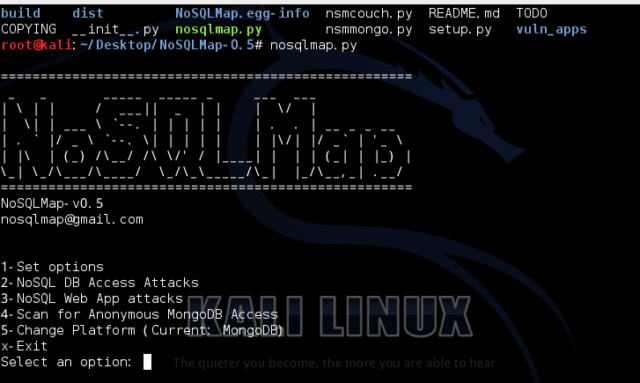NoSQLMap is an open source Python-based automated NoSQL MongoDB exploitation tool designed to audit for as well as automate injection attacks and exploit default configuration weaknesses in NoSQL databases. It is also intended to attack web applications using NoSQL in order to disclose data from the database.

What is NoSQLMap?
Presently the tool’s exploits are focused around MongoDB, but additional support for other NoSQL based platforms such as CouchDB, Redis, and Cassandra are planned in future releases.
A NoSQL (originally referring to “non SQL”, “non-relational” or “not only SQL”) database provides a mechanism for storage and retrieval of data which is modelled by means other than the tabular relations used in relational databases. Such databases have existed since the late 1960s, but did not obtain the “NoSQL” moniker until a surge of popularity in the early twenty-first century, triggered by the needs of Web 2.0 companies such as Facebook, Google, and Amazon.com.
NoSQL databases are increasingly used in big data and real-time web applications. NoSQL systems are also sometimes called “Not only SQL” to emphasize that they may support SQL-like query languages.
And if you’ve been paying attention, you’ll know you will need some help with MongoDB Security.
Don’t forget to check this too: mongoaudit – MongoDB Auditing & Pen-testing Tool
Requirements for NoSQL MongoDB Exploitation
On a Debian or Red Hat based system, the setup.sh script may be run as root to automate the installation of NoSQLMap’s dependencies.
Varies based on features used:
- Metasploit Framework,
- Python with PyMongo,
- httplib2,
- and urllib available.
- A local, default MongoDB instance for cloning databases to
There are some various other libraries required that a normal Python installation should have readily available. Your mileage may vary, check the script.
NoSQLMap MongoDB Hacking Usage Options
- Set target host/IP-The target web server (i.e. www.google.com) or MongoDB server you want to attack.
- Set web app port-TCP port for the web application if a web application is the target.
- Set URI Path-The portion of the URI containing the page name and any parameters but NOT the host name (e.g. /app/acct.php?acctid=102).
- Set HTTP Request Method (GET/POST)-Set the request method to a GET or POST; Presently only GET is implemented but working on implementing POST requests exported from Burp.
- Set my local Mongo/Shell IP-Set this option if attacking a MongoDB instance directly to the IP of a target Mongo installation to clone victim databases to or open Meterpreter shells to.
- Set shell listener port-If opening Meterpreter shells, specify the port.
- Load options file-Load a previously saved set of settings for 1-6.
- Load options from saved Burp request-Parse a request saved from Burp Suite and populate the web application options.
- Save options file-Save settings 1-6 for future use.
You can download NoSQLMap here:
Or read more here.
